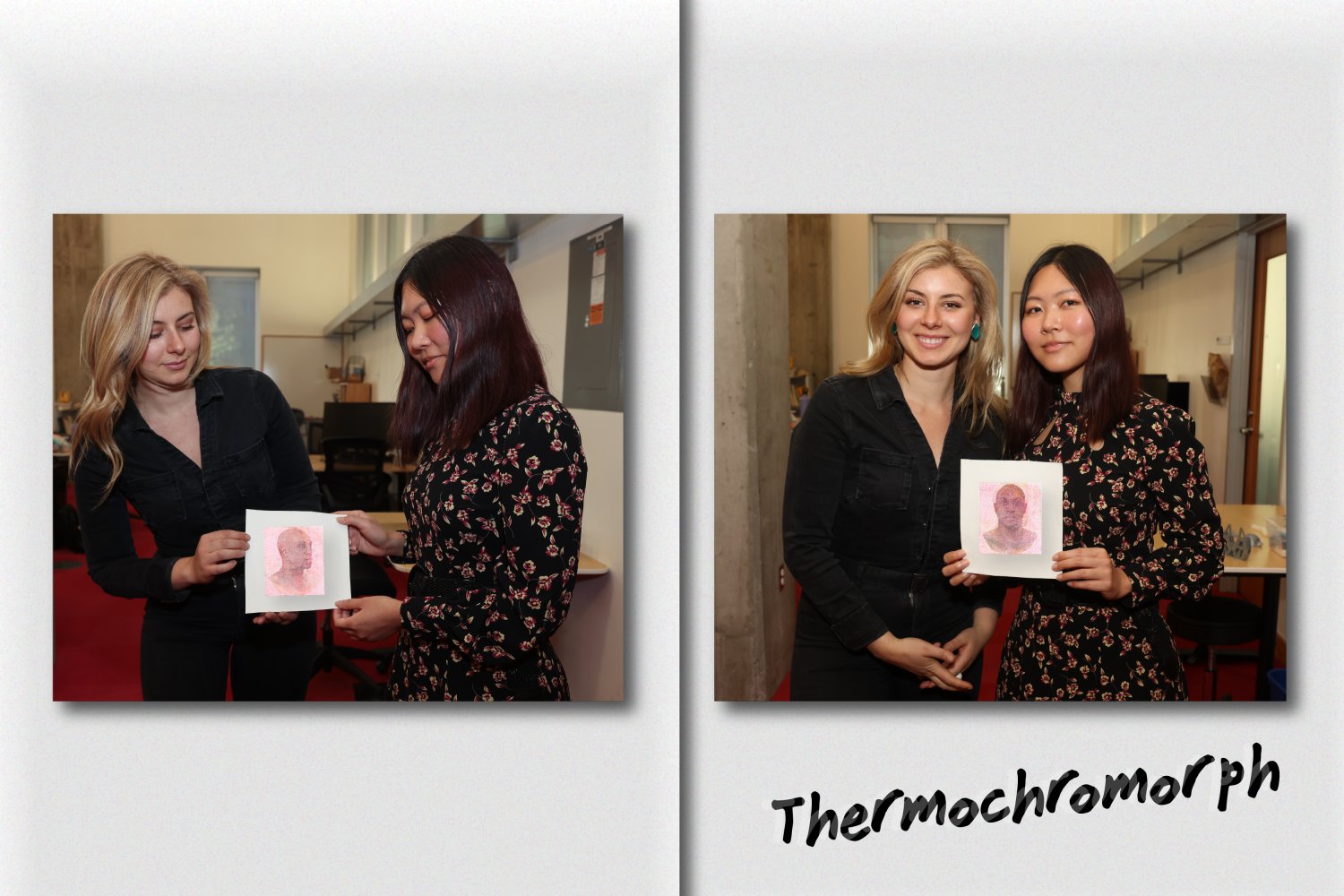Researchers in MIT Professor Stefanie Mueller’s group have spent much of the last decade developing a variety of computing techniques aimed at reimagining how products and systems are designed. Much in the way that platforms like Instagram allow users to modify 2-D photographs with filters, Mueller imagines a world where we can do the same thing for a wide array of physical objects.
In a new open-access paper, her team at MIT’s Computer Science and Artificial Intelligence Laboratory (CSAIL) has demonstrated a novel printing technique along these lines — which they call “Thermochromorph” — that produces images that can change colors when heated up.
Led by first author and MIT electrical engineering and computer science doctoral student Ticha Melody Sethapakdi SM ’22, the researchers say that they could imagine their method being applied in ways that are both artistic and functional, like a coffee-cup that warns if the liquid is too hot, or packaging for medicines or perishable foods that could indicate if the product has been stored at a safe temperature.
Thermochromorph: Transforming images through heat
Video: MIT CSAIL
So-called “thermochromic” materials that visually change with temperature are not new — you can see examples with consumer beverages like Coke and Coors Light that reveal “ready to drink” labeling when refrigerated. But such instances in product marketing have traditionally been limited to a single color. By using inks with complementary characteristics — with one set that goes from clear to colored, and another from colored to clear — Sethapakdi says that she and her colleagues are “finally taking advantage of full-color process printing, which opens up a lot of possibilities for designing with thermochromic materials.”
The researchers worked with several visual artists to teach them to use Thermochromorph, and then solicited feedback and brainstorming about new narrative concepts and techniques unlocked by the tool, like color-changing postcards that could tell sequential stories in more compact, dynamic ways. One participant even plans to use Thermochromorph to make an educational science kit aimed at teaching students about sea creatures that change color.
The team developed their method to be applied specifically to “relief printing,” an early form of printmaking that involves carving a design into a block of material, applying ink or pigment to it, and then transferring the image onto paper or another surface.
Sethapakdi says that, compared to techniques like screen printing, relief printing is “more lightweight” and can be done with less setup and fewer materials, enabling a faster, lower-stakes iteration process. Artists that include the likes of Pablo Picasso and Salvador Dalí have used a range of related approaches in their work, such as woodcut and linocut printing.
“Our key contribution is applying these new materials to a traditional artistic process, and exploring how artists might be able to use it as part of their practice,” says Sethapakdi, lead author on a related paper that was recently presented at SIGGRAPH Asia in Tokyo.
The color-changing component also need not come from an active external heating or cooling source like, say, a fridge or a hot plate; using thermochromic inks with lower activation temperatures can allow for more subtle thermal changes brought about by human touch. Sethapakdi says she could even imagine applying this new process to create interactive surfaces or dynamic analog “interfaces” that visually change in response to touch.
Thermochromorph combines digital and analog processes in the form of, on the one hand, CMYK imaging and laser cutting, and, on the other, manual printmaking and thermochromic inks. Fabrication involves four core steps:
- Block preparation: Solid hardwood blocks are used for Thermochromorph. The blocks are laser cut and engraved with the desired design, and then rinsed with water to remove any leftover particles.
- Inking the block: First, a thin layer of ink is spread evenly onto a plate using a rubber brayer. Then, the ink is transferred from the brayer to the woodblock.
- Registration: A registration jig is used to position the woodblock to ensure the different ink layers are aligned correctly. The printing surface, such as paper, is then placed on top of the block and secured.
- Printing the images: A printing press is used to apply even pressure across the printing surface and transfer the ink from the block to the surface. The hot image is printed first, followed by the cold image. (If necessary, additional ink can be applied to specific areas of the block to touch up the print.)
The three prints the team used to demonstrate their technique were a set of frames from a Batman comic, a label depicting a fish and its underlying skeleton, and an image of a male subject both in profile and viewed from the front. (For the latter, as the temperature changes, the viewpoint gradually shifts, giving the effect of motion.)
It’s worth noting that Thermochromorph does have some potential limitations related to image resolution and print quality. Specifically, image resolution is constrained by the smallest dot size that the team’s laser cutter can engrave. Techniques like screen printing would offset this, but with the additional drawback of needing more time and materials. In terms of print quality, the pigments are not entirely invisible in their ‘clear’ states, which means that the clarity of the transitions depends on how thickly the ink layers were applied during printmaking. While this issue is intrinsic to the properties of the pigments, Sethapakdi says that for future iterations the team plans to explore different image-processing techniques to modify the overlay of halftone patterns for the hot and cold images, which may help to reduce these visual artifacts.
Sethapakdi and Mueller co-authored the new paper alongside Juliana Covarrubias ’24, MIT graduate student in media arts and sciences Paris Myers, University of California at Berkeley PhD student Tianyu Yu, and Adobe Research Scientist Mackenzie Leake.

